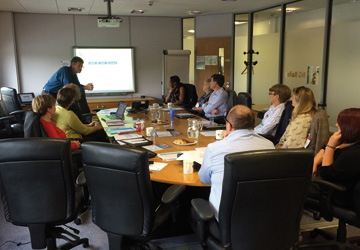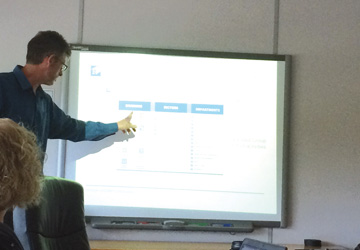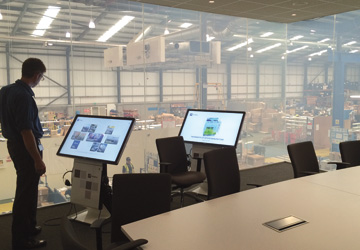T.U.G. News - December 2015
Linda Spinks presents the latest news from the User Group
We Tell You
User Group Meeting - 10th September 2015
Well as Christmas fast approaches the last User Group meeting seems so long ago, however I do remember it to be a very enjoyable and informative day. The meeting was hosted by Steve Ward at NG Bailey's offsite manufacturing facility in Bradford, and wow what a day we had. I don't think anyone will forget the reaction given by Julie Mack at the rather impressive Privacy Smartglass wall onto which was projected a corporate presentation, before it magically changed to clear glass, so that we were overlooking the factory. The tour was very interesting and I think we were all very impressed at the kind of savings that can be made from such offsite manufacturing. I was particularly impressed to see Lean principles being applied so effectively (having just completed Lean Six Sigma training myself). Steve also gave us a good insight into his project from the original objectives, when they first adopted the Triaster solution, through to the changes they have made in order to cater for their audience, many of whom like to see things presented in a particular way.
We would also like to share with you, the Connector reader, some of the discussion points that were raised during the two workshop sessions, which we all found very useful to talk through.
How do you capture return on investment (ROI)?
This workshop was called following a number of recent discussions that came up within the customer assessments. These highlighted that many customers aren't sure how to best capture return on investment information around the use of the Triaster system and indeed in some cases the internal Business Improvement teams themselves.
The points below show that there's quite a range of factors to be taken into account when considering ROI. One of the key differentiators being whether you have senior support for a system that is fundamental to the successful running of your business; such as conformance to industry standards and Health, Safety and Risk compliance, or whether your management team are looking for you to achieve specific savings and find business improvement solutions by mapping and analysing your processes. For many customers the answer was not so much, 'why should we do this?' but more about 'what will happen if we don't?'
We hope that the examples and comments made regarding capturing ROI, are a useful reminder of why you do what you do and will maybe help you to justify all the hard work and money that goes into it.
The decrease in 'how do I calls' to our HR support centre once our Library was introduced.
The time and cost taken to do an annual stock take was collated and showed that failure to follow the process results in increased time and costs. Financial data was provided to back this up.
Repeatable processes can be measured fairly easily, but unique processes are more difficult to measure.
Look at the current level of failure vs targeted levels.
The fact that processes are in place and documented is a benefit.
The cost saving of the reduction in external audit time resulting from having documented processes.
Having our International Student process documented, saves time when being audited.
We recognise significant benefits, especially around auditing for multiple sites and regarding the visibility of documented processes.
For ISO certification it's essential to have a Process Library.
ROI from the AA's perspective is the fact that a legacy system was not upgradeable for a reasonable cost and our Triaster Library is more efficient, more stable and upgradeable.
Risk management is the return on investment.
Another ROI is the ability to have access to processes for fieldworkers.
Documented processes support and prevent costs in accidents / rework / litigation / fines etc.
Maps used as part of project work won't necessarily end up in a library, but value adds into the achievement of improvement.
Documented processes are perceived as fair and equal.
Level of Mapping
The second workshop was about what level everyone was mapping to, and how that worked for them.
The main questions asked were:
'At what level should you stop mapping?' & 'How much detail should be included?'
The AA advised that they map procedures as well as process, so everything is in map format. Users are used to this, as they have been using this format for many years. There were some points to note as follows though:
- Some processes are mapped which shouldn't be!!
- Procedures are tailored to the AA user 's skill level.
Other comments were:
- When the Project process is mapped, all steps should be included at top level, but the first step should have a decision about which project steps are to be included by project value, risk analysis.
- The map shows 'what' but you can include a decision matrix about 'how' the decision is made and which are the mandatory and optional documents - you can use data visualisation to identify mandatory steps.
- The level of detail may be impacted if maps are used as a training resource for new starters, although maybe work instructions sitting behind maps is the better option.
The ANSWER?
Essentially all agreed that, 'it depends on your audience'.
How many levels work? Some don't use drill downs at all.
Drill downs are useful for processes that are reused e.g. peer review.
Running an end-to-end map when all on one level, we can easily visualise the spider's web and highlight areas to review with complexity.
Respond to the 'Voice of Customer' - what do they understand from the map?
Development Update
Also covered on the day was an update from Triaster, which included a Software Development update from Andrew Ridgeley.
Work in progress:
- Map Reviews
- Document Approvals
- Process Metrics:
- Auto-generates Lean 6 Sigma metrics (Cost, Effort, Cycle Time). Can configure custom metrics.
- Reports Available (like Report Exchange).
- TO-BE and AS-IS site comparison, giving Improvement Implementation Plan.
- Improved Upgrade Process (one-click installation, avoid need for manual configuration).
- Planning Chart: to be re-purposed as an Audit Scheduling Tool.
In the short term we are looking at:
- Easier Configuration: Use of 'wizards' rather than editing XML.
- Single logon for Approvals and Administration (potentially linked to Active Directory in time).
- News Page Enhancements (display as default screen, easier editing and management of items).
- New Library Hosted Solution - 100% cloud based.
In the longer term:
- New Map Publication Format
- Web-based Property Update
- Web-based Mapping Solution (offered in parallel with Process Navigator)
Next Main User Group meeting
The next User Group meeting is being hosted by the AA at their Oldbury offices on 9th March 2016.
If you are unable to attend in person (maybe you are based outside of the UK, or just can't get away from the office for the whole day) please remember that we open to making arrangements for other customers to join in particular discussions via conference call/web sessions. If this is of interest for the next meeting, please contact us and we'll see what we can do in collaboration with the host, to involve you on the day.
If you would like to host a meeting, or have any questions about the User Group please drop us an e-mail to user.group@triaster.co.uk



